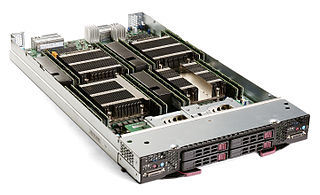Related Research Articles

Computing is any goal-oriented activity requiring, benefiting from, or creating computing machinery. It includes the study and experimentation of algorithmic processes, and development of both hardware and software. Computing has scientific, engineering, mathematical, technological and social aspects. Major computing disciplines include computer engineering, computer science, cybersecurity, data science, information systems, information technology and software engineering.

An operating system (OS) is system software that manages computer hardware and software resources, and provides common services for computer programs.

PowerPC is a reduced instruction set computer (RISC) instruction set architecture (ISA) created by the 1991 Apple–IBM–Motorola alliance, known as AIM. PowerPC, as an evolving instruction set, has been named Power ISA since 2006, while the old name lives on as a trademark for some implementations of Power Architecture–based processors.

A router is a networking device that forwards data packets between computer networks. Routers perform the traffic directing functions between networks and on the global Internet. Data sent through a network, such as a web page or email, is in the form of data packets. A packet is typically forwarded from one router to another router through the networks that constitute an internetwork until it reaches its destination node.

A supercomputer is a computer with a high level of performance as compared to a general-purpose computer. The performance of a supercomputer is commonly measured in floating-point operations per second (FLOPS) instead of million instructions per second (MIPS). Since 2017, supercomputers have existed which can perform over 1017 FLOPS (a hundred quadrillion FLOPS, 100 petaFLOPS or 100 PFLOPS). For comparison, a desktop computer has performance in the range of hundreds of gigaFLOPS (1011) to tens of teraFLOPS (1013). Since November 2017, all of the world's fastest 500 supercomputers run on Linux-based operating systems. Additional research is being conducted in the United States, the European Union, Taiwan, Japan, and China to build faster, more powerful and technologically superior exascale supercomputers.
A network operating system (NOS) is a specialized operating system for a network device such as a router, switch or firewall.

In computing, a server is a piece of computer hardware or software that provides functionality for other programs or devices, called "clients". This architecture is called the client–server model. Servers can provide various functionalities, often called "services", such as sharing data or resources among multiple clients or performing computations for a client. A single server can serve multiple clients, and a single client can use multiple servers. A client process may run on the same device or may connect over a network to a server on a different device. Typical servers are database servers, file servers, mail servers, print servers, web servers, game servers, and application servers.
Processor power dissipation or processing unit power dissipation is the process in which computer processors consume electrical energy, and dissipate this energy in the form of heat due to the resistance in the electronic circuits.

A blade server is a stripped-down server computer with a modular design optimized to minimize the use of physical space and energy. Blade servers have many components removed to save space, minimize power consumption and other considerations, while still having all the functional components to be considered a computer. Unlike a rack-mount server, a blade server fits inside a blade enclosure, which can hold multiple blade servers, providing services such as power, cooling, networking, various interconnects and management. Together, blades and the blade enclosure form a blade system, which may itself be rack-mounted. Different blade providers have differing principles regarding what to include in the blade itself, and in the blade system as a whole.
Green computing, green IT, or ICT sustainability, is the study and practice of environmentally sustainable computing or IT.
Cisco Certifications are the list of the Certifications offered by Cisco Systems. There are four or five levels of certification: Associate (CCNA/CCDA), Professional (CCNP/CCDP), Expert (CCIE/CCDE) and recently Architect, as well as nine different paths for the specific technical field; Routing & Switching, Design, Industrial Network, Network Security, Service Provider, Service Provider Operations, Storage Networking, Voice, Datacenter and Wireless.
There are also a number of the specialist technician, sales, Business, data center certifications, CCAI certified instructor.

A computer is a machine that can be programmed to carry out sequences of arithmetic or logical operations (computation) automatically. Modern digital electronic computers can perform generic sets of operations known as programs. These programs enable computers to perform a wide range of tasks. The term computer system may refer to a nominally complete computer that includes the hardware, operating system, software, and peripheral equipment needed and used for full operation; or to a group of computers that are linked and function together, such as a computer network or computer cluster.

Intel Active Management Technology (AMT) is hardware and firmware for remote out-of-band management of select business computers, running on the Intel Management Engine, a microprocessor subsystem not exposed to the user, intended for monitoring, maintenance, updating, and repairing systems. Out-of-band (OOB) or hardware-based management is different from software-based management and software management agents.
IT energy management or Green IT is the analysis and management of energy demand within the Information Technology department in any organization. IT energy demand accounts for approximately 2% of global CO2 emissions, approximately the same level as aviation, and represents over 10% of all the global energy consumption. IT can account for 25% of a modern office building's energy cost.
Cisco Unified Computing System (UCS) is a data center server computer product line composed of server hardware, virtualization support, switching fabric, and management software, introduced in 2009 by Cisco Systems. The products are marketed for scalability by integrating many components of a data center that can be managed as a single unit.

The Open Compute Project (OCP) is an organization that shares designs of data center products and best practices among companies, including Arm, Meta, IBM, Wiwynn, Intel, Nokia, Google, Microsoft, Seagate Technology, Dell, Rackspace, Hewlett Packard Enterprise, NVIDIA, Cisco, Goldman Sachs, Fidelity, Lenovo and Alibaba Group.
Information technology (IT) is a set of related fields that encompass computer systems, software, programming languages and data and information processing and storage. IT forms part of information and communications technology (ICT). An information technology system is generally an information system, a communications system, or, more specifically speaking, a computer system — including all hardware, software, and peripheral equipment — operated by a limited group of IT users, and an IT project usually refers to the commissioning and implementation of an IT system.
Electronic systems’ power consumption has been a real challenge for Hardware and Software designers as well as users especially in portable devices like cell phones and laptop computers. Power consumption also has been an issue for many industries that use computer systems heavily such as Internet service providers using servers or companies with many employees using computers and other computational devices. Many different approaches have been discovered by researchers to estimate power consumption efficiently. This survey paper focuses on the different methods where power consumption can be estimated or measured in real-time.

Cache hierarchy, or multi-level caches, refers to a memory architecture that uses a hierarchy of memory stores based on varying access speeds to cache data. Highly requested data is cached in high-speed access memory stores, allowing swifter access by central processing unit (CPU) cores.
References
- ↑ Rezaur Rahman (3 September 2013). Intel Xeon Phi Coprocessor Architecture and Tools: The Guide for Application Developers. Apress. pp. 92–. ISBN 1-4302-5927-2.
- ↑ Scaramella, Jed. Eastwood, Matthew. "Solutions for the Datacenter's Thermal Challenges" Archived 2016-08-06 at the Wayback Machine . IDC Headquarters, Framingham, Massachusetts, 2007.
- ↑ Manish Parashar; Salim Hariri (15 December 2006). Autonomic Computing: Concepts, Infrastructure, and Applications. CRC Press. pp. 345–. ISBN 978-1-4200-0935-4.
- ↑ Kiran Mani; Bradley Jee (14 December 2007). On the Edge: A Comprehensive Guide to Blade Server Technology. John Wiley & Sons. pp. 104–. ISBN 978-0-470-82304-0.
- ↑ ""POV-Ray power consumption and efficiency", Tech Report,
- ↑ David Hucaby (January 2004). CCNP BCMSN Exam Certification Guide: CCNP Self-study. Cisco Press. pp. 66–. ISBN 978-1-58720-077-9.
- ↑ Richard Froom; Balaji Sivasubramanian; Erum Frahim (21 June 2010). Implementing Cisco IP Switched Networks (SWITCH) Foundation Learning Guide: Foundation learning for SWITCH 642-813. Cisco Press. pp. 222–. ISBN 978-1-58714-165-2.
- ↑ Ishfaq Ahmad; Sanjay Ranka (3 February 2016). Handbook of Energy-Aware and Green Computing - Two Volume Set. CRC Press. pp. 695–. ISBN 978-1-4822-5444-0.